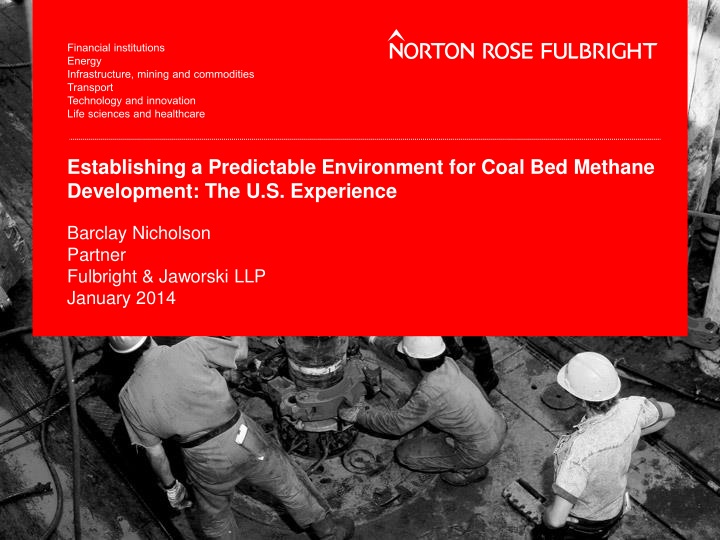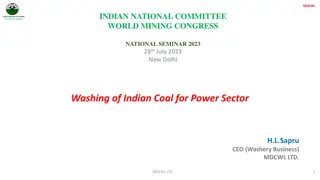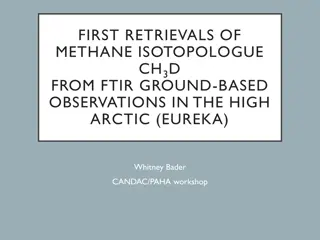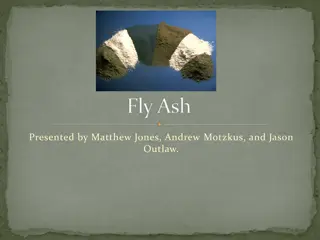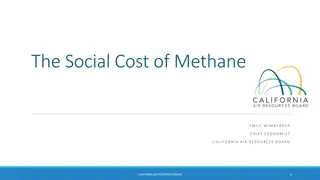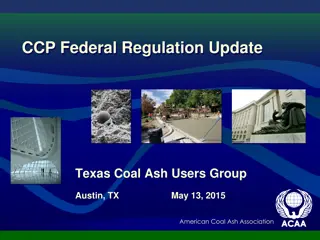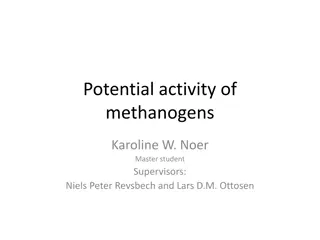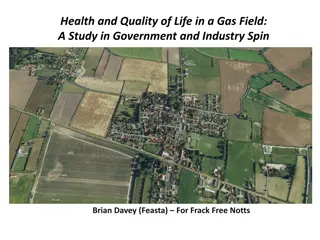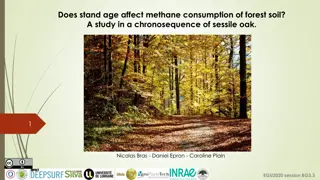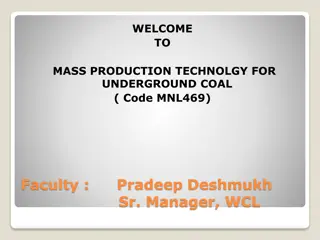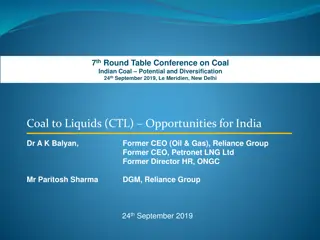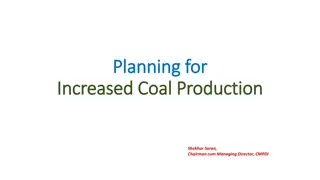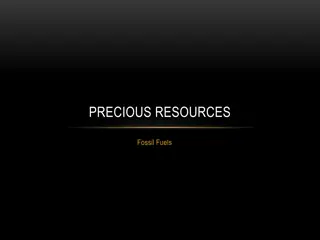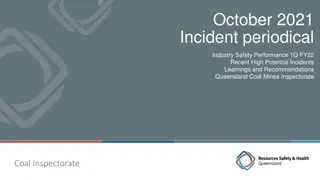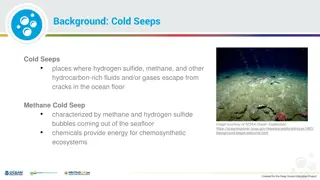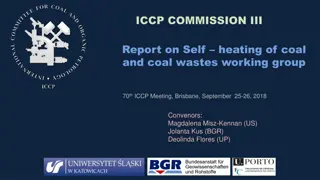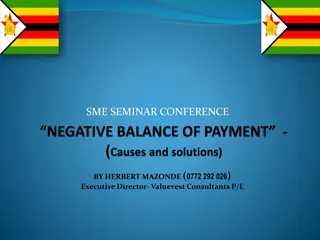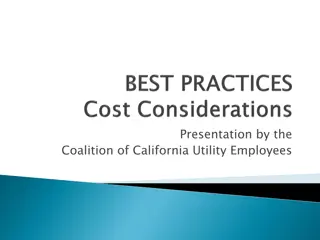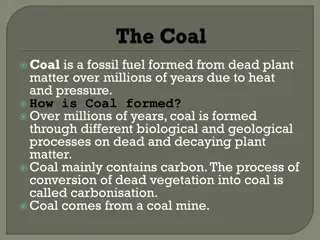Coal Bed Methane Development: Potential, Challenges, and Environment
Explore the potential and concerns surrounding coal bed methane (CBM) in Colombia, discussing the gas content, economic viability, technological challenges, environmental impacts, and development coordination.
Uploaded on Sep 23, 2024 | 2 Views
Download Presentation

Please find below an Image/Link to download the presentation.
The content on the website is provided AS IS for your information and personal use only. It may not be sold, licensed, or shared on other websites without obtaining consent from the author.If you encounter any issues during the download, it is possible that the publisher has removed the file from their server.
You are allowed to download the files provided on this website for personal or commercial use, subject to the condition that they are used lawfully. All files are the property of their respective owners.
The content on the website is provided AS IS for your information and personal use only. It may not be sold, licensed, or shared on other websites without obtaining consent from the author.
E N D
Presentation Transcript
Establishing a Predictable Environment for Coal Bed Methane Development: The U.S. Experience Barclay Nicholson Partner Fulbright & Jaworski LLP January 2014
Coal Basins in Colombia Colombia has proved coal reserves of at least 6.8 billion tons. Coal bed methane (CBM) is a gas created during the formation of coal seams. It is an unconventional resource as the methane is contained in the coal and does not migrate to other rock strata. Colombia s significant coal reserves have a coal rank suitable for CBM exploitation. CBM total potential estimates in Colombia range from 11 to 35 TCF, although only a portion of these reserves will be economically recoverable. 2 barclay.nicholson@nortonrosefulbright.com
Coal Bed Methane Potential and Concerns Methane from coal is an attractive resource. Coal can store large volumes of methane-rich gas 6 or 7 times as much gas as a conventional natural gas reservoir of equal rock volume can hold. Much of the coal and its methane lies at shallow depths, making wells easy to drill and inexpensive to complete. Exploration costs for CBM are low, and the wells are cost effective to drill. Technological and environmental difficulties and costs Water permeates coal beds, and its pressure traps methane within the coal. To produce methane from coal beds, water must be drawn off first, lowering the pressure so methane can flow out of the coal and to the well bore. This water, which is commonly saline or in some areas potable, must be disposed of in an environmentally acceptable manner. Surface disposal of large volumes of potable water can affect streams, groundwater sources, and other habitats. Subsurface re-injection adds to the cost of production. Methane is a greenhouse gas, which in the atmosphere, can trap heat and contribute to global warming. 3 barclay.nicholson@nortonrosefulbright.com
CBM Characteristics and Challenges Evaluating a CBM prospect Gas in place Gas content: Coal rank, composition of the coal, burial history Total coal in place: Extent of coal in the area, net coal seam thickness Storage capacity: Saturation indicates recoverable gas Economic gas deliverability determined by Thickness of coal seams, permeability, spacing of coal seams, depth of coal seams, hydrology, depositional environment, saturation, geologic structure, reservoir pressure Challenges Significant technology needs, higher capital requirements, longer development times, higher production costs, reservoir management complexities Gathering, transportation and marketing challenges Environmental challenges Development plans and coordination with transportation infrastructure 4 barclay.nicholson@nortonrosefulbright.com
Ownership As interest in unconventional energy resources increases, recovery and utilization of coal bed methane is expanding. In the U.S., however, industry lacks a uniform legal framework governing CBM ownership. The question of who owns or has rights to the methane adsorbed to a particular coal estate does not have a straightforward answer. In most cases, a coal lease holder does not have automatic rights to CBM and must work with the gas lease holder, the surface owner, the government, or a combination of the three to resolve the issue. Principles of private mineral rights ownership in the U.S. Estates in land are capable of division. Mineral rights can be severed from the surface estate. There can be a division of mineral estates rights to coal or oil and gas, rights based on depth or geological horizon, etc. Split estate concepts Mineral estate is dominant. Reasonable vs. unreasonable interference Necessary and incidental use of surface 5 barclay.nicholson@nortonrosefulbright.com
Two Approaches to Coal Bed Methane Ownership Substantive rules of property Seeks to provide prospective predictability by adopting a set of rules that can be applied to any conveyance to resolve the ownership issue. Relies upon judicially-adopted rules of property to govern the parties rights. Examples: A court may hold that anytime coal is conveyed, it is the conveyance of a container which includes anything within the confines of the coal container, including coal bed methane gas. Another rule might be gas is not coal so a conveyance of coal does not include gas that might be found within the coal. Procedural contract principles Seeks to give effect to the intent of the parties on a case-by-case basis. Relies upon an evidentiary process for ascertaining the intent of the parties, without regard for rules of property. Weakness Inconsistency in decisions 6 barclay.nicholson@nortonrosefulbright.com
Ownership: Case Law Examples U.S. Steel Corp. v. Hoge (Pennsylvania, 1983) Conveyance dated 1920 All the coal of the Pittsburgh or River Vein underlying all that certain tract of land Together with all the rights and privileges necessary useful in the mining and removing of said coal, including the right of mining without leaving any support the right of ventilation and drainage and of access to the mines for men and materials. The [surface owners] hereby reserve the right to drill and operate through said coal for oil and gas without being held liable for any damages. Decision: [A]s a general rule, subterranean gas is owned by whoever has title to the property in which the gas is resting. When a landowner conveys a portion of his property, in this instance coal, to another, it cannot thereafter be said that the property conveyed remains as part of the former s land, since title to the severed property rests solely in the grantee. In accordance with the foregoing principles governing gas ownership, therefore, such as is present in coal must necessarily belong to the owner of the coal, so long as it remains within his property and subject to his exclusive dominion and control. 7 barclay.nicholson@nortonrosefulbright.com
Ownership Case Law Examples Amoco Production Co. v. Southern Ute Indian Tribe (U.S. Supreme Court, 1999) Land patents issued pursuant to the Coal Lands Acts of 1909 and 1910 conveyed the land and everything in it, except the coal, which was reserved by the United States. Issue: Whether Congress in 1909 and 1910 regarded coal bed methane as a constituent of coal. Court considered: In 1909 and 1910, dictionaries defined coal as a solid fuel resource. The Coals Lands Acts were passed to address the concerns about the short supply of coal. Natural gas was not an important energy source in the early 1900 s. Decision [W]e conclude that the most natural interpretation of coal as used in the 1909 and 1910 Acts does not encompass CBM gas In all events, even were we to construe the coal reservation to encompass CBM gas, a split estate would result. The United States concedes (and the Tribe does not dispute) that once the gas originating in the coal formation migrates to surrounding rock formations it belongs to the natural gas, rather than the coal estate. Natural gas from other sources may also exist in the lands at issue. Including CBM gas in the coal reservation would, therefore, create a split gas estate that would be at least as difficult to administer as a split coal/CBM estate. If CBM gas were reserved with the coal estate, those developing the natural gas resources in the land would have to allocate the gas between the natural gas and coal estates based on some assessment of how much had migrated outside the coal itself. There is no reason to think Congress would have been more concerned about the creation of a split coal/CBM gas estate than the creation of a split gas estate. 8 barclay.nicholson@nortonrosefulbright.com
Ownership: Case Law Examples Energy Development Corp. v. Moss (West Virginia, 2003) Conveyance dated 1986 all of the oil and gas and all of the constituents of either in and under the land hereinafter described in all possible productive formations therein and thereunder Issue: Whether coal bed methane had been leased to the company. Extrinsic evidence considered: In 1986 there was no coal bed methane development in the area and the company had not engaged in any coal bed methane development up to the time of trial. Decision The coal bed methane belonged to the lessor. Newman v. RAG Wyoming Land Co. (Wyoming, 2002) Conveyance Fee owners granted all coal and minerals commingled with coal that may be mined or extracted in association therewith or in conjunction with such coal operations while reserving to the grantors all oil, gas and other minerals except as set forth above. Extrinsic evidence considered: Grantors had entered into an oil and gas lease covering oil, gas, and casinghead gas, and other minerals in 1968. In 1971, grantee was conducting coal mining operations on surrounding lands. Oil and gas production and coal mining proceeded simultaneously on the land. Coal bed methane is chemically identical to methane gas produced through conventional methods, and each is known as natural gas. Decision Under the plain meaning of the terms chosen by the parties to the deed, we cannot conclude they intended to include coalbed methane as a mineral mined or extracted in association therewith or in conjunction with such coal operations when it can only be produced through wells as any other gas. 9 barclay.nicholson@nortonrosefulbright.com
U.S. Regulation In the U.S., there are multi-levels of government (federal, state, county, and municipality) affecting when, where, how, and what to drill. The rules include permit applications, completion and production reports, disclosure requirements, casing and cementing standards, and zoning restrictions. Federal Land use plans are the principal documents used to govern the development of mineral extraction on federal lands. Opening areas to activities addressed in the plans requires an Environmental Assessment or Environmental Impact Statement. Leases issued on federal land are competitively bid. Submission of an Application for Permit to Drill with a Plan of Development Laws governing water, air, endangered species, antiquities, and other resources. Safe Drinking Water Act, National Pollution Discharge Elimination System, Underground Injection Control Program, Resource Conservation and Recovery Act, and Comprehensive Environmental Response, Compensation, and Liability Act State State oil and gas commissions and boards established to oversee oil and gas operations by establishing well integrity requirements, drilling units, and well permit and operations regulations. Water laws, including acquisition, use and disposal 10 barclay.nicholson@nortonrosefulbright.com
What It Takes to Succeed Evidence of sizeable resources to attract interest in CBM development Economic and fiscal incentives Extend exploration and development times Block extensions Access to domestic markets Availability of infrastructure Promotion of natural gas utilization Participation of specialized players to ensure that experiences developed elsewhere are utilized Government sponsored R&D funding Critical attention to environmental challenges (carbon footprint, air quality, water management, land disturbance, waste disposal) 11 barclay.nicholson@nortonrosefulbright.com
Disclaimer Norton Rose Fulbright LLP, Norton Rose Fulbright Australia, Norton Rose Fulbright Canada LLP, Norton Rose Fulbright South Africa (incorporated as Deneys Reitz Inc) and Fulbright & Jaworski LLP, each of which is a separate legal entity, are members ( the Norton Rose Fulbright members ) of Norton Rose Fulbright Verein, a Swiss Verein. Norton Rose Fulbright Verein helps coordinate the activities of the Norton Rose Fulbright members but does not itself provide legal services to clients. References to Norton Rose Fulbright , the law firm , and legal practice are to one or more of the Norton Rose Fulbright members or to one of their respective affiliates (together Norton Rose Fulbright entity/entities ). No individual who is a member, partner, shareholder, director, employee or consultant of, in or to any Norton Rose Fulbright entity (whether or not such individual is described as a partner ) accepts or assumes responsibility, or has any liability, to any person in respect of this communication. Any reference to a partner or director is to a member, employee or consultant with equivalent standing and qualifications of the relevant Norton Rose Fulbright entity. The purpose of this communication is to provide information as to developments in the law. It does not contain a full analysis of the law nor does it constitute an opinion of any Norton Rose Fulbright entity on the points of law discussed. You must take specific legal advice on any particular matter which concerns you. If you require any advice or further information, please speak to your usual contact at Norton Rose Fulbright. 13
